Just wow, guys. The Nintendo 64 trumped the PlayStation in a very heated poll. For more details you can find last week's post here.
As usual, here's a recap of the rules.
So what's next? Some of you may have noticed the title of the Third Generation of Handhelds. I don't expect any surprises here, but let's go through the motions anyway, shall we?
The Third Generation of handhelds is an assorted bunch. The only real innovations we see here is the beginning of a new breed of handhelds that would continue to thrive in the Asian market in the future, and the shuddering gait of a newborn cell phone gaming system trying to find it's legs.
Enough banter! Let's get to it!
This Week's Challengers are:
The Neo Geo Pocket Color
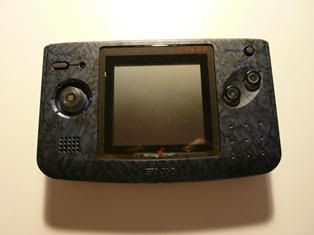
The NGPC's predecessor managed to make enough of an impact in the Japanese market to warrant a revision. That came in the form of a Color version which was later released in Europe and North America. I've already described some of the NGPC's unique features, but I'll say once again that it was a beast of a handheld that was only limited by it's library size. If it had the same third party support that Nintendo's handhelds have enjoyed these many years, we may have seen an NGPAdvance or some such device.
This this was released in 1999 and didn't fare too well once the GBA was released. While it's reported to have sold 2 million units, that number if mixed in with the original units sales.
The Bandai SwanCrystal
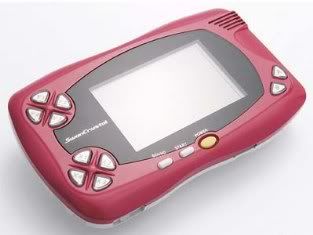
Another familiar face! After the relative success of it's predecessor (the WonderSwan), Bandai released the SwanCrystal to the market.
Released in 2002, this little machine was not much of an upgrade over the WonderSwan color save for the much clearer TFT screen and the much larger cartridge size. It was too little too late though, as it was not able to make much of an impact.
The Game Boy Advance
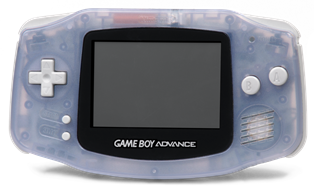
Well well! Nintendo seemed to have been following a Sega-style hardware release schedule at the time. Hot on the heels of the 3-year-old Game Boy Color (which itself was hot on the heels of the 2-year-old Virtual Boy), was the release of the Game Boy Advance!
Released in 2001, the game Boy Advance was launched with a myriad of games, some of which were quite good (namely Castlevania: circle of the Moon, and Super Dodgeball Advance being two of my personal favourites). The system was initially criticized for having an old-style non-backlit screen, even though that was the standard at the time. To compensate for this, some people resorted to Worm lights or the Afterburner Kit (among others) to bring lighted goodness to the system. Nintendo eventually got the idea and released the frontlit Game Boy Advance SP, which was criticized for it's lack of headphone jack.
The next two revisions technically fall into this generation, as they were revisions of the GBA, but they were released after the DS' lifecycle began as Nintendo hoped to use the GBA as their 'third pillar' (probably as a backup plan in case the DS failed like the Virtual Boy did). In 2005 Nintendo announced and subsequently released the Game Boy micro (lower case 'm') which boasted a wonderfully backlit screen, horizontal controls, all in a 'cell phone sized' package. Around the same time Nintendo quietly released what I call the SP2, which was a Game Boy Advance SP with a backlit screen. Both are well sought after devices.
Here at GBATemp, the GBA is known for making piracy/homebrew that much more accessible. Flash carts and the like had existed for years before the GBA, but it wasn't until the GBA that they started to become more widely available to North Americans (I have no info on Europe).
All in all the GBA did quite well for itself. As of 2010 the Game Boy Advance line has sold 81.5 million units worldwide, a number that was only surpassed by it's successor. It's also no surprise that it's best selling games were Pokemon Ruby and Sapphire.
The GamePark GP32
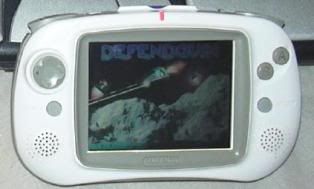
So what the hell is this thing? I think I'm the only person in the western world who owns one of these (correct me if I'm wrong). The GP32 was the first outing by a Korean company called Game Park. Now, Game Park knew they couldn't compete with the Game Boy (Advance or otherwise) because they didn't have the clout or third party support that they did, so they made the GP32 a relatively open handheld platform, probably the first of it's kind. It took the, now defunct, Smart Media card and could be loaded with some of the few third party games that were released for it, as well as countless emulators and homebrew games that permeated its lifetime.
The GP32 was released in 2001 and had three different units available: the NLU (which didn't have a light installed of any kind), the FLU (the Front Lit Unit) and the BLU (Back Lit Unit). How many units were sold is not known, but Game Park was successful enough to go on to make more consoles (eventually splitting into two companies) and single-handedly started a peripheral gaming community.
The Tapwave Zodiac
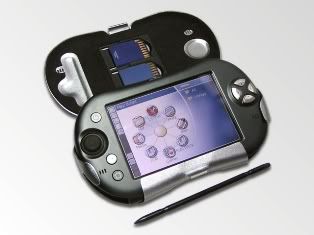
Released in 2003, this handheld hoped to cash in on the handheld market, but just like so many before it, it was widely ignored. It ran off a modified version of the Palm OS and marketed itself as a multimedia system.
Sadly, it's release was a year before the highly anticipated Nintendo DS, and then later, the PlayStation Portable.
The Tapwave sold less than 200,000 units and was taken from shelves in 2005. The company then sold it's assets and no longer exists.
The Nokia N-Gage
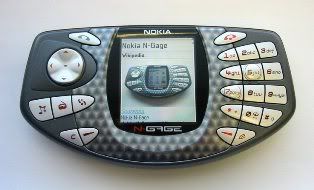
Yes yes. Side talking. Ha ha. Now that we've got that out of our systems, let's talk about Nokia's quirky foray into the handheld world.
At the time, Nokia was still one of the mobile world's brightest stars, and it came as a slight shock that Nokia was marketing their phone as a gaming system. You'll have to remember that back in 2003, before Smart Phones or the iPhone, the mobile/cell phone wasn't considered much of a gaming platform (outside of Japan anyway). It seemed like the next logical step, but somehow Nokia missed the mark.
Many complained about the screen orientation, which was taller than it was wide, a standard configuration for phones at the time, but something unseen in the video gaming world. Others complained about the poor quality of games on the system, which boasted such names as Tomb Raider, Splinter Cell, Red Faction, Sonic, and even an Elder Scrolls game. All of which were awful (some of which were shitty ports of GBA games). And because the N-Gage used MMC cards (predecessor to SD cards), they were very easily pirated too, and one could simply buy a card of their own and fill it with downloaded games.
In an effort to bolster sales, Nokia ended up releasing the Nokia N-Gage QD, which was essentially the same phone, but lacked the bluetooth features of the predecessor, and was in a nicer looking package. Because the original was dubbed a 'taco' by the public, it's unsure if Nokia called the redesign the QD as a joke, because it invited the obvious name of QuesaDilla.
While the N-Gage did support an online component, it was buggy, unreliable, expensive, and slow.
The N-Gage is said to have sold at least 3 million units (this number does not include the QD model), and was considered to be an alright phone at the time. It did not fare well as a gaming device, but it paved the way for what is now a major contender in the video game market.
Housekeeping!!
So there you have it! Six varied competitors! We all know who will win, but that doesn't make it any less fun! Cheers!
The Brackets stand thusly, BTW:
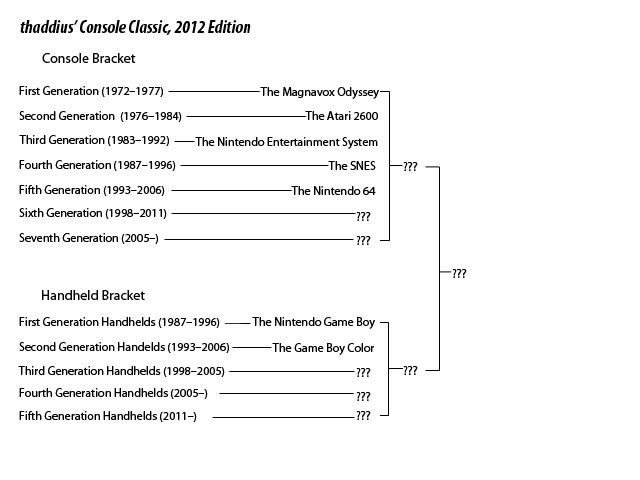
Who will win? It could be you!*
*Note: It can't be you.
Don't forget to vote! And join us next week as we enter another controversial round!
EDIT: The poll is now closed. I will be posting the results soon.
As usual, here's a recap of the rules.
Each week, video game history will be put to the test to see which console or handheld is the greatest. There can only be one!
Vote for your favourite and follow it through to the end as we try to determine GBATemp's favourite console/handheld!
Consoles and handhelds will face off in brackets comprised of their generation. Because there can only be one, in the event of a tie I will cast a tie-breaking vote. Once a winner has been declared for each generation, the console winners and the handheld winners will face off in individual brackets. Once an ultimate console and ultimate handheld have been chosen, they will face off against each other to see who is the greatest!
For a concrete example of the brackets, see the image at the bottom of this post.
Consoles and handhelds will face off in brackets comprised of their generation. Because there can only be one, in the event of a tie I will cast a tie-breaking vote. Once a winner has been declared for each generation, the console winners and the handheld winners will face off in individual brackets. Once an ultimate console and ultimate handheld have been chosen, they will face off against each other to see who is the greatest!
For a concrete example of the brackets, see the image at the bottom of this post.
So what's next? Some of you may have noticed the title of the Third Generation of Handhelds. I don't expect any surprises here, but let's go through the motions anyway, shall we?
The Third Generation of handhelds is an assorted bunch. The only real innovations we see here is the beginning of a new breed of handhelds that would continue to thrive in the Asian market in the future, and the shuddering gait of a newborn cell phone gaming system trying to find it's legs.
Enough banter! Let's get to it!
This Week's Challengers are:
The Neo Geo Pocket Color

The NGPC's predecessor managed to make enough of an impact in the Japanese market to warrant a revision. That came in the form of a Color version which was later released in Europe and North America. I've already described some of the NGPC's unique features, but I'll say once again that it was a beast of a handheld that was only limited by it's library size. If it had the same third party support that Nintendo's handhelds have enjoyed these many years, we may have seen an NGPAdvance or some such device.
This this was released in 1999 and didn't fare too well once the GBA was released. While it's reported to have sold 2 million units, that number if mixed in with the original units sales.
The Bandai SwanCrystal

Another familiar face! After the relative success of it's predecessor (the WonderSwan), Bandai released the SwanCrystal to the market.
Released in 2002, this little machine was not much of an upgrade over the WonderSwan color save for the much clearer TFT screen and the much larger cartridge size. It was too little too late though, as it was not able to make much of an impact.
The Game Boy Advance

Well well! Nintendo seemed to have been following a Sega-style hardware release schedule at the time. Hot on the heels of the 3-year-old Game Boy Color (which itself was hot on the heels of the 2-year-old Virtual Boy), was the release of the Game Boy Advance!
Released in 2001, the game Boy Advance was launched with a myriad of games, some of which were quite good (namely Castlevania: circle of the Moon, and Super Dodgeball Advance being two of my personal favourites). The system was initially criticized for having an old-style non-backlit screen, even though that was the standard at the time. To compensate for this, some people resorted to Worm lights or the Afterburner Kit (among others) to bring lighted goodness to the system. Nintendo eventually got the idea and released the frontlit Game Boy Advance SP, which was criticized for it's lack of headphone jack.
The next two revisions technically fall into this generation, as they were revisions of the GBA, but they were released after the DS' lifecycle began as Nintendo hoped to use the GBA as their 'third pillar' (probably as a backup plan in case the DS failed like the Virtual Boy did). In 2005 Nintendo announced and subsequently released the Game Boy micro (lower case 'm') which boasted a wonderfully backlit screen, horizontal controls, all in a 'cell phone sized' package. Around the same time Nintendo quietly released what I call the SP2, which was a Game Boy Advance SP with a backlit screen. Both are well sought after devices.
Here at GBATemp, the GBA is known for making piracy/homebrew that much more accessible. Flash carts and the like had existed for years before the GBA, but it wasn't until the GBA that they started to become more widely available to North Americans (I have no info on Europe).
All in all the GBA did quite well for itself. As of 2010 the Game Boy Advance line has sold 81.5 million units worldwide, a number that was only surpassed by it's successor. It's also no surprise that it's best selling games were Pokemon Ruby and Sapphire.
The GamePark GP32

So what the hell is this thing? I think I'm the only person in the western world who owns one of these (correct me if I'm wrong). The GP32 was the first outing by a Korean company called Game Park. Now, Game Park knew they couldn't compete with the Game Boy (Advance or otherwise) because they didn't have the clout or third party support that they did, so they made the GP32 a relatively open handheld platform, probably the first of it's kind. It took the, now defunct, Smart Media card and could be loaded with some of the few third party games that were released for it, as well as countless emulators and homebrew games that permeated its lifetime.
The GP32 was released in 2001 and had three different units available: the NLU (which didn't have a light installed of any kind), the FLU (the Front Lit Unit) and the BLU (Back Lit Unit). How many units were sold is not known, but Game Park was successful enough to go on to make more consoles (eventually splitting into two companies) and single-handedly started a peripheral gaming community.
The Tapwave Zodiac

Released in 2003, this handheld hoped to cash in on the handheld market, but just like so many before it, it was widely ignored. It ran off a modified version of the Palm OS and marketed itself as a multimedia system.
Sadly, it's release was a year before the highly anticipated Nintendo DS, and then later, the PlayStation Portable.
The Tapwave sold less than 200,000 units and was taken from shelves in 2005. The company then sold it's assets and no longer exists.
The Nokia N-Gage

Yes yes. Side talking. Ha ha. Now that we've got that out of our systems, let's talk about Nokia's quirky foray into the handheld world.
At the time, Nokia was still one of the mobile world's brightest stars, and it came as a slight shock that Nokia was marketing their phone as a gaming system. You'll have to remember that back in 2003, before Smart Phones or the iPhone, the mobile/cell phone wasn't considered much of a gaming platform (outside of Japan anyway). It seemed like the next logical step, but somehow Nokia missed the mark.
Many complained about the screen orientation, which was taller than it was wide, a standard configuration for phones at the time, but something unseen in the video gaming world. Others complained about the poor quality of games on the system, which boasted such names as Tomb Raider, Splinter Cell, Red Faction, Sonic, and even an Elder Scrolls game. All of which were awful (some of which were shitty ports of GBA games). And because the N-Gage used MMC cards (predecessor to SD cards), they were very easily pirated too, and one could simply buy a card of their own and fill it with downloaded games.
In an effort to bolster sales, Nokia ended up releasing the Nokia N-Gage QD, which was essentially the same phone, but lacked the bluetooth features of the predecessor, and was in a nicer looking package. Because the original was dubbed a 'taco' by the public, it's unsure if Nokia called the redesign the QD as a joke, because it invited the obvious name of QuesaDilla.
While the N-Gage did support an online component, it was buggy, unreliable, expensive, and slow.
The N-Gage is said to have sold at least 3 million units (this number does not include the QD model), and was considered to be an alright phone at the time. It did not fare well as a gaming device, but it paved the way for what is now a major contender in the video game market.
Housekeeping!!
So there you have it! Six varied competitors! We all know who will win, but that doesn't make it any less fun! Cheers!
The Brackets stand thusly, BTW:

Who will win? It could be you!*
*Note: It can't be you.
Don't forget to vote! And join us next week as we enter another controversial round!
EDIT: The poll is now closed. I will be posting the results soon.








